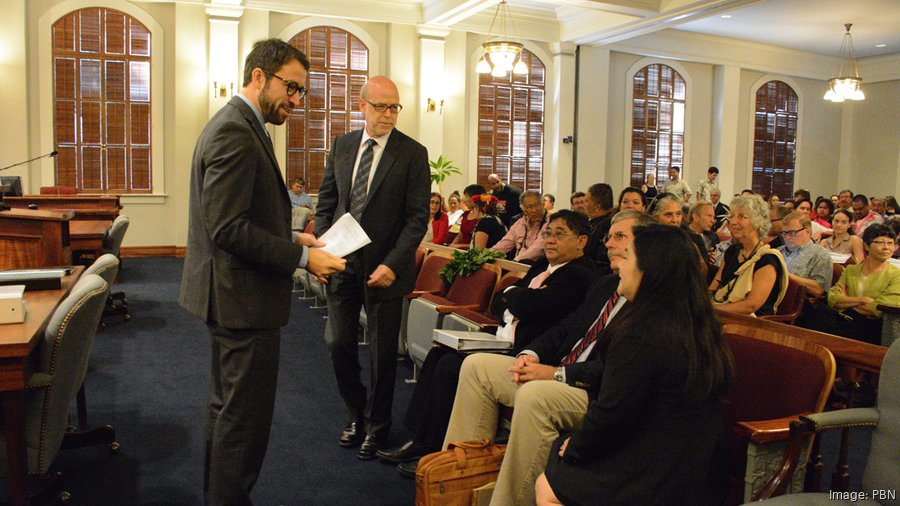Attorneys representing the state, the University of Hawaii and opponents of the planned Thirty Meter Telescope project presented their cases in oral arguments before the Hawaii Supreme Court in Downtown Honolulu Thursday morning.
Mauna Kea Anaina Hou, Clarence Ching, Flores-Case Ohana, Deborah Ward, Paul Neves, and KAHEA: The Hawaiian Environmental Alliance filed a lawsuit against the Hawaii Board of Land and Natural Resources and University of Hawaii at Hilo, challenging the state-awarded permit to construct the observatory on the summit of the Big Island.
The groups appealing the case had requested a transfer of the case from the Hawaii State Judiciary Intermediate Court of Appeals to the Hawaii Supreme Court and the transfer was granted in June.
The court’s decision could mark the culmination of seven years spent in planning the contested telescope and could decide the fate of the $1.4 billion project.
Click on the photo for a slideshow.
Much of the discussion between the justices and attorneys addressed the state land board's approval process for a land use permit awarded to TMT.
The state issued a conservation district use permit for the project in 2011, subject to conditions. Contested case hearings ensued that August and September.
A hearings officer issued a ruling in 2012 that concluded that TMT aligns with conservation district uses and should be granted the permit.
State attorneys said Thursday the permit was officially approved in 2013, and the 2011 permit was "preliminary."
TMT opponents, who argue any further development will have a detrimental impact on the environment and will inhibit cultural practices, appealed the approval that year, but in May 2014, the 3rd Circuit Court affirmed the board's decision to grant the permit to University of Hawaii at Hilo.
The state at the time had determined TMT Observatory Corp. satisfied legal requirements and the project would not cause significant harm to the physical and cultural environment.
The appellants' attorney, Richard Naiwieha Wurdeman, argued that the permit was awarded improperly and a decision was made prematurely. Although appellants were granted contested case hearings, he argued that the hearings came after a decision was made to grant the permit, calling it a “repugnant” violation of due process.
Wurdeman maintained that the existing 13 telescopes atop Mauna Kea and their management by the university have caused a “significant adverse impact” and said his clients have the right to another contested case hearing in front of the board.
The “only remedy” would be to take the case back to the board, which has entirely new members, he said.
Jay Handlin, attorney for respondent UH Hilo, told the justices that the decision to award the permit was a result of a process that included years of outreach and revision “to a degree that is unprecedented in the history” of astronomical pursuits atop the mountain.
“We did go ahead and have a full blown contested case hearing,” he told the justices, noting that the project did not move forward before an outcome came from the contested case hearing and the following decision by the state land board.
Deputy Attorney General Julie China argued on behalf of BLNR that the board’s permit was part of a “preliminary consideration,” and when the board regathered to make a final decision, it looked at the permit with “new eyes.”
“This was a preliminary consideration — if this was a final determination of the permit at that time, [appellants] wouldn't have had time to appeal,” she told the justices. “The state DLNR understood that it was a preliminary permit, and at no time did they see injunctive relief for the telescope proceeding any further. All parties saw it as a preliminary matter.”
“The Board of Land and Natural Resources went above and beyond what was required in its review of the permit application," Attorney General Doug Chin told PBN after the arguments were heard. "We look forward to seeing the Court’s ruling.”
Several rounds of arrests of protestors have been made on Mauna Kea since April, when protest activities blocked access to the TMT construction site.
In July, Gov. David Ige authorized emergency rules prohibiting overnight camping and access to the summit area.
It is uncertain when the Supreme Court will issue an opinion in the case.






